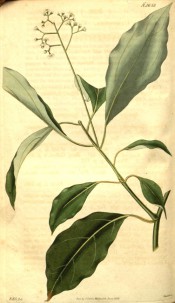Cinnamomum camphora (L.) Nees & Eberm.
Frost tender, erect to spreading tree with aromatic, boldly-veined, glossy, ovate leaves, reddish when young, and clusters of small, bowl-shaped, greenish flowers in spring and summer, followed by black berries. To 20m. [RHSE, Hilliers’].
Horticultural & Botanical History
‘It is a native of Japan, where it grows into a stately tree, which Kaempfer compares to the European Lime or Linden Tree. Every part of the tree, but more especially the root abounds with camphor, which the peasantry prepare from it by a rude distillation. It is exported to the East Indies and to Europe, where it is refined by sublimation, and comes to our market in large cakes, freed from all impurities.’ [BM t.2658/1826]. Introduced to Europe in 1727. [PD].
History at Camden Park
Listed in all published catalogues [T.629/1843]. Probably a very early introduction to the gardens, possibly with the intent of assessing its commercial possibilities.. Edward Macarthur provided seed to the Sydney Botanic Garden in 1823. [RBGS AB]. A weed in parts of the Sydney region and north into Queensland.
Notes
Published Mar 03, 2010 - 11:30 AM | Last updated Jul 25, 2010 - 04:04 PM
| Family | Lauraceae |
|---|---|
| Category | |
| Region of origin | Tropical Asia |
| Synonyms |
|
| Common Name | Camphor tree, Camphor laurel |
| Name in the Camden Park Record |
Laurus camphora - Camphor Laurel |
| Confidence level | high |
